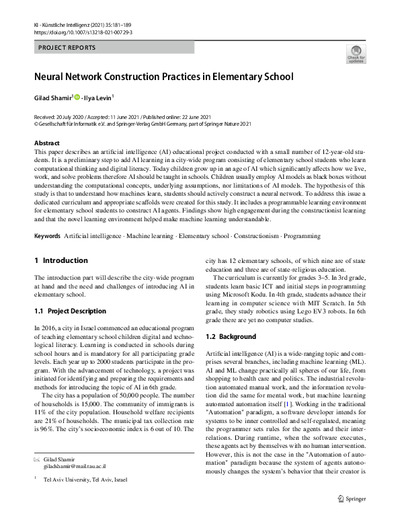Neural Network Construction Practices in Elementary SchoolGilad Shamir, Ilya Levin
Erstpublikation in: KI - Künstliche Intelligenz (2021) 35:181–189
|
 |
 Diese Seite wurde seit 1 Jahr inhaltlich nicht mehr aktualisiert.
Unter Umständen ist sie nicht mehr aktuell.
Diese Seite wurde seit 1 Jahr inhaltlich nicht mehr aktualisiert.
Unter Umständen ist sie nicht mehr aktuell.
 Zusammenfassungen
Zusammenfassungen
This paper describes an artifcial intelligence (AI) educational project conducted with a small number of 12-year-old students. It is a preliminary step to add AI learning in a city-wide program consisting of elementary school students who learn
computational thinking and digital literacy. Today children grow up in an age of AI which signifcantly afects how we live,
work, and solve problems therefore AI should be taught in schools. Children usually employ AI models as black boxes without
understanding the computational concepts, underlying assumptions, nor limitations of AI models. The hypothesis of this
study is that to understand how machines learn, students should actively construct a neural network. To address this issue a
dedicated curriculum and appropriate scafolds were created for this study. It includes a programmable learning environment
for elementary school students to construct AI agents. Findings show high engagement during the constructionist learning
and that the novel learning environment helped make machine learning understandable.
Von Gilad Shamir, Ilya Levin im Text Neural Network Construction Practices in Elementary School  Bemerkungen
Bemerkungen
Von Beat Döbeli Honegger, erfasst im Biblionetz am 21.09.2022
 Dieser wissenschaftliche Zeitschriftenartikel erwähnt ...
Dieser wissenschaftliche Zeitschriftenartikel erwähnt ...
 Dieser wissenschaftliche Zeitschriftenartikel erwähnt vermutlich nicht ...
Dieser wissenschaftliche Zeitschriftenartikel erwähnt vermutlich nicht ... 
 Nicht erwähnte Begriffe | Digitalisierung, Eltern, LehrerIn, Lernen, Schweiz, Unterricht |
 Tagcloud
Tagcloud
 Zitationsgraph
Zitationsgraph
 Zitationsgraph (Beta-Test mit vis.js)
Zitationsgraph (Beta-Test mit vis.js)
 1 Erwähnungen
1 Erwähnungen 
- Machine Learning for Teachers - Evaluation und Entwicklung von Lehr- und Lernmaterialien zum Thema Künstliche Intelligenz für Lehrpersonen ab Sekundarstufe 1 (Thomas Zurfluh) (2022)

 Anderswo finden
Anderswo finden
 Volltext dieses Dokuments
Volltext dieses Dokuments
 |  Neural Network Construction Practices in Elementary School: Artikel als Volltext ( Neural Network Construction Practices in Elementary School: Artikel als Volltext ( : :  , 881 kByte; , 881 kByte;  : :  ) ) |
 Anderswo suchen
Anderswo suchen 
 Beat und dieser wissenschaftliche Zeitschriftenartikel
Beat und dieser wissenschaftliche Zeitschriftenartikel
Beat hat Dieser wissenschaftliche Zeitschriftenartikel während seiner Zeit am Institut für Medien und Schule (IMS) ins Biblionetz aufgenommen. Beat besitzt kein physisches, aber ein digitales Exemplar. Eine digitale Version ist auf dem Internet verfügbar (s.o.). Es gibt bisher nur wenige Objekte im Biblionetz, die dieses Werk zitieren.










 Kinder
Kinder Künstliche Intelligenz (KI / AI)
Künstliche Intelligenz (KI / AI) LOGO (Programmiersprache)
LOGO (Programmiersprache) machine learning
machine learning Programmieren
Programmieren Schule
Schule Scratch
Scratch




 Biblionetz-History
Biblionetz-History